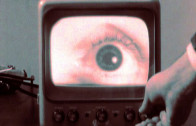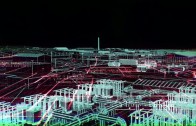All Watched Over By Machines of Loving Grace
All Watched Over By Machines Of Loving Grace is a series of films about how this culture itself has been colonised by the machines it has has built. The series explores and connects together some of the myriad ways in which the emergence of cybernetics—a mechanistic perspective of the natural world that particularly emerged in the 1970s along with emerging computer technologies—intersects with various historical events and visa-versa. The series variously details the interplay between the mechanistic perspective and the catastrophic consequences it has in the real world.
Series
Part one explores the myth that rose up in the 1990s that computers could create a new kind of stable world: They would bring about a new kind global capitalism purportedly free of risk and failure, without the boom and bust of the past; they would abolish centralised political power, and create a new kind of democracy mediated by technology and the Internet, where millions of people would be connected as nodes in cybernetic systems without hierarchy. This film explores how this myth came to be by following two groups that converged on the ideas. One is the small group of disciples around the novelist Ayn Rand in the 1950s who saw themselves as a prototype for a future society where everyone could follow their own selfish desires and that would somehow create a stable and equitable society. The other is the digital entrepreneurs of Silicon Valley, many of whom were also disciples of Ayn Rand, that espoused grand visions of global utopia to be delivered by their technology. They believed that new computer networks would allow the creation of a society where everyone would also follow their own self-interest but that would similarly somehow miraculously bringing a stable and equitable society too. They were joined by Alan Greenspan who had also been a disciple of Ayn Rand, who became convinced that the computers were creating a new kind of “stable capitalism.”
Part two shows how the modern scientific perspective of the natural world is actually a fantasy. It has little to do with the reality of nature. It is based on mechanistic ideas that were projected on to the natural world in the 1950s by scientists: That nature is a giant cybernetic machine of order that sees humans, and everyone else on the planet, as merely cogs in that machine. In an age disillusioned with modern politics, these ideas began to take on a new appeal, as the “self-regulating ecosystem” model became the basis for the utopian vision of society where technocrats would provide new ways of governing without leaders or politics, along with global visions of connectivity analogous, they claim, to the Gaia theory. These ideas emerged out of the hippie communes in the United States in the 1960s and from counter-culture computer scientists who believed that global webs of computers could liberate the world. But, at the very moment this was happening, the science of ecology discovered that the theory of the self-regulating ecosystem wasn’t true. Instead what was found was that nature is really dynamic and constantly changing in myriad ways. But it was too late, the dream of the self-organising network had already captured the imagination of the technologists and the wider culture, unwilling to revise technological “progress.”
This episode looks at why popular culture finds this machine vision so beguiling. The film posits that it is perhaps as all past political dreams of changing the world for the better seem to have failed, the retreat into machine-fantasies that reinforce the desire for it to be true that we have no control over our actions, is an excuse and rationalisation of our failure. At the basis of the film is Bill Hamilton, a scientist. He claimed that human behaviour is guided by codes buried deep within us—a theory later popularised by Richard Dawkins as the so-called “selfish gene.” Fundamentally, these people claimed that individual human beings are really just machines whose only job is to make sure their ‘genetic codes are passed on for eternity.’ This final part in the series sets out to explain why these theories are problematic, beginning in 2000 in the jungles of the Congo and Rwanda, where Hamilton is to espouse his dark theories. But all around him the Congo is being torn apart. The film then interweaves the two stories: The strange roots of Hamilton’s theories, and the history of the West’s tortured exploitation of the Congo in order to continue manufacturing the technology that keeps the West’s dogmatic utopian ideas alive.




